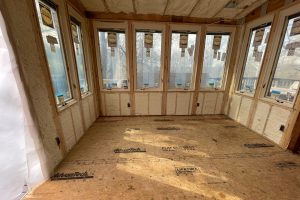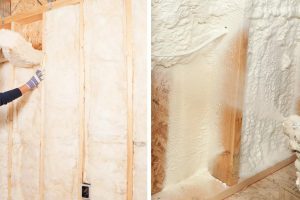If you’re building a new home or planning to retrofit an older one, the question of insulation is crucial. This process can greatly affect your long-term energy usage and costs, not to mention your comfort. Let’s take a close look at the benefits and potential drawbacks of spray foam insulation, a common choice among homeowners and builders alike.
Understanding the Basics of Spray Foam Insulation

Spray foam insulation refers to a range of spray-applied plastic foam insulation materials used to insulate buildings and seal cracks and gaps. It is an alternative to traditional insulation materials like fiberglass and cellulose. Spray foam insulation is a two-part liquid that expands and hardens when mixed, forming a solid plastic foam that adheres and seals wherever it is applied.
There are two main types of spray foam insulation: open-cell and closed-cell. Both are made from polyurethane, but have different densities and formulations. Understanding the differences between these two types is key to selecting the right spray foam for your insulation needs.
What is Spray Foam Insulation?
Spray foam insulation is made by combining an isocyanate and a resin blend in a mixing spray gun. As the liquids are mixed and sprayed, they chemically react, expand, and cure to form rigid foam plastic. The foam expands 30-60 times its original mixed volume as it cures, filling cracks, gaps, and voids as it adheres to surfaces. The cured foam is an effective air seal and thermal barrier.
Unlike fiberglass and cellulose, spray foam completely fills the spaces it’s sprayed into. It molds and seals to odd-shaped cavities, corners, and around wires, pipes, ducts, and other penetrations. Its airtight sealing capability dramatically improves energy efficiency and comfort.
The Two Types of Spray Foam Insulation: Open-Cell vs. Closed-Cell
There are two types of spray foam insulation with different densities and properties:
- Open-cell spray foam insulation: has a lower density (0.4-0.8 lbs/ft3). The cells of the cured foam are not completely closed, leaving small pockets of air. Open-cell foam has good air sealing ability and insulation value (R-3.5 per inch). It provides insulation, air sealing, and moisture control in buildings.
- Closed-cell spray foam insulation: has a higher density (1.8-2.3 lbs/ft3). The closed cell structure gives it increased R-value (R-5.8-7.4 per inch), strength, and moisture resistance. Closed-cell spray foam is a vapor barrier and can be used in exterior applications.
The Role of Spray Foam Insulation in Residential and Commercial Infrastructure
Spray foam insulation is versatile for residential and commercial buildings. Applications include:
- Attics: Open or closed-cell spray foam helps seal attics and roof assemblies.
- Walls: Foam insulation improves wall insulation and air sealing.
- Crawl spaces: Closed-cell spray foam insulates floors and crawlspaces.
- Basements: Sealing and insulating basement rim joists and foundations.
- Air sealing: Sealing gaps, cracks, and penetrations to improve air tightness.
- Acoustics: Reduces noise transmission in interior walls and floors.
Foam insulation is useful for retrofits, renovations, and new construction. It works well with common framing methods and materials. The liquid foam can fill small gaps and seal challenging areas other insulations cannot.
Pros of Spray Foam Insulation
There are many benefits that make spray foam insulation a smart choice for buildings:
Superior Energy Efficiency and High R-value
Spray foam has a high R-value per inch compared to other insulations. R-values range from R-3.5 to R-7.4 per inch depending on foam type. The high insulation value and complete fill allow foam to improve energy efficiency.
Buildings insulated with spray foam require less energy for heating and cooling. Homeowners can save 20-50% on energy bills after foam insulation installation.
Robust Air and Moisture Barrier
Spray foam insulation expands and seals wherever it is applied, controlling air leakage and drafts. Tight foam insulation improves indoor air quality and protects against moisture damage.
Foam acts as an air barrier system that meets stringent air tightness requirements for high-performance buildings. It seals the building envelope against exterior air and pollutants.
Long-Life Span and Durability
Properly installed spray foam insulation will last for the life of the building. It does not settle or degrade over time. Closed-cell foam is especially resistant to moisture and condensation.
Foam insulation adds strength and rigidity to walls, roofs, and ceilings. It resists mold growth and damage from freezing and thawing.
Cons of Spray Foam Insulation
While spray foam insulation has many benefits, there are also some potential drawbacks to consider:
Higher Up-Front Costs
The installed cost of spray foam insulation is higher than traditional fiberglass or cellulose. Expect to pay 20-50% more for spray foam insulation.
However, foam insulation often costs less than other high-performance insulations. It can also yield energy savings that offset the investment over time.
Potential for Decreased Ventilation
If closed-cell spray foam insulation is used throughout the entire property, then ventilation may be disrupted. There is a place in the home for both open and closed-cell spray foam and your installer should know when and where to use both.
Overall, spray foam insulation offers meaningful energy efficiency and performance benefits for many applications. Being aware of the pros and cons allows for informed comparison of insulation options.
Making an Informed Decision: Factors to Consider
When it comes to insulation, spray foam is one of the most effective options available today. However, like any product, it has both pros and cons to weigh. Doing your research and understanding your specific insulation needs are key to making an informed decision.
There are two main types of spray foam insulation: open-cell and closed-cell. Open-cell spray foam is less dense and made with polyurethane. It’s more affordable but less rigid. Closed-cell spray foam is denser, made with isocyanate, and provides a higher R-value per inch. It’s more expensive but blocks moisture better.
Assessing your insulation needs: Commercial vs Residential
Your insulation needs depend largely on whether it’s for commercial or residential use. For homes, factors like climate, window efficiency, and utility costs impact the R-value you need. For commercial buildings, structural considerations, HVAC systems, and occupancy also come into play.
An energy audit can determine where a building is losing heat and recommend insulation upgrades. Spray foam works well for irregularly shaped areas and filling gaps. It adheres tightly for consistent insulation without sagging over time.
Understanding and comparing R-Values
R-value measures an insulation’s resistance to conductive heat flow. The higher the R-value, the better its insulating performance. Most homes need an insulation R-value of R-30 in the attic and R-13 in walls.
The R-value of spray foam depends on its density and thickness. Closed-cell spray foam provides an R-value of R-6 to R-7.4 per inch. Open cell ranges from R-3.5 to R-4 per inch. Compare costs and installation considerations when choosing insulation R-values.
Balancing Cost, Efficiency, and Health Considerations
Spray foam costs can vary per square foot. It’s more expensive upfront than fiberglass or cellulose, but long-term energy savings often offset the costs.
Spray polyurethane foam doesn’t allow air leakage, making it up to 50% more efficient than other insulation. Proper installation is key to maximize performance.
Conclusion: Is Spray Foam Insulation Right for You?
When properly installed, spray foam insulation offers exceptional efficiency and airflow sealing. It works well for reducing energy costs in irregularly shaped areas. Evaluate your climate, HVAC, and budget to determine if it’s the best choice for your insulation needs.
Be sure to research the latest formulations to find a spray foam product with minimal health and environmental impacts. With the right prep and protective gear, spray foam allows for a customizable insulation solution.
Trust Cincinnati RetroFoam for Spray Foam Insulation
When it comes to spray foam insulation in Cincinnati homes and buildings, there’s one company you can trust – Cincinnati RetroFoam.
As a local company rooted in Cincinnati, we understand our climate, older housing stock, and the benefits spray foam can offer. We offer top-quality open and closed-cell foam solutions to match your project. This leads to optimal energy efficiency and comfort improvements. From start to finish, you can rely on our team of seasoned professionals to implement spray foam insulation right. We take care of assessing your existing insulation and determining ideal spray points.
If you’re looking to upgrade your home’s insulation with spray foam, look no further than the experts at Cincinnati RetroFoam. Our tailored solutions, outstanding service, and results you can count on make us the smart choice for foam insulation.
FAQs
Is spray foam insulation worth it?
Spray foam insulation can be worth the investment for certain homeowners. It provides excellent insulation and air-sealing properties compared to traditional insulation materials like fiberglass batts. The higher upfront cost of spray foam is often justified by long-term energy savings and improved comfort.
When should you not use spray foam?
Spray foam insulation can be an effective way to insulate homes or buildings. However, there are some situations where spray foam may not be the best choice. Injection or blow-in insulation might work better in other circumstances.
